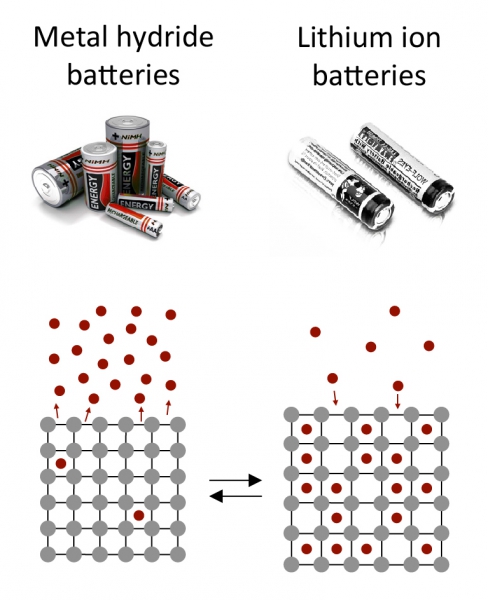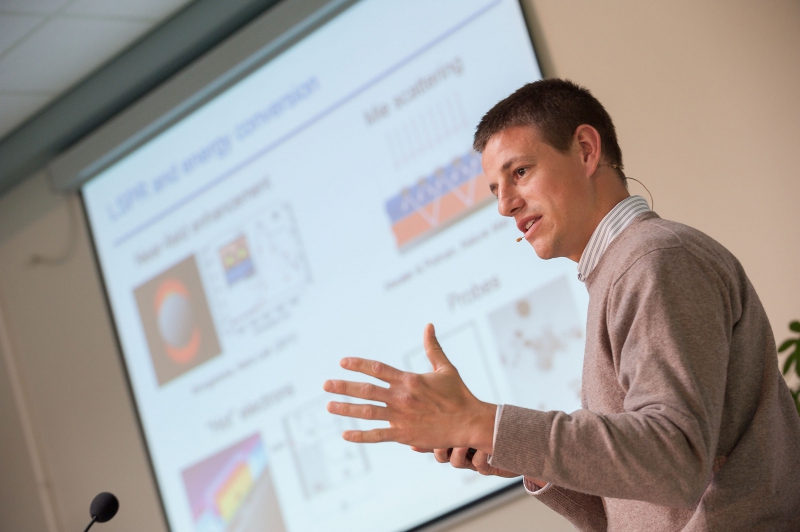16 April 2016
In Nature Materials, nanomaterials researcher Andrea Baldi at DIFFER and colleagues at Stanford University present a new in-situ method to visualize phase transitions inside individual nanoparticles. With their technique they can distinguish which parts of a single nanoparticle are active in absorbing hydrogen and link the observed behavior to the presence and nanoscale spatial arrangement of defects and strain. Understanding these transitions is key to optimize a wide range of technologically relevant processes, from energy storage in batteries, to information storage in volatile memories and chemical reactions on metal nanoparticle catalysts.
Publication
Reconstructing solute-induced phase transformations within individual nanocrystals
T. C. Narayan*, A. Baldi*, A.L. Koh, R. Sinclair, J. A. Dionne
Nature Materials (2016), doi:10.1038/nmat4620
* these authors contributed equally to this work.
Fractured batteries
Most of the batteries that power our smartphones, laptops, and soon our cars, are based on a mechanism in which small atoms are absorbed into a solid, very much like water being absorbed into a sponge. Charging and discharging of such batteries often involves large changes in volume, which can cause fracture of the materials and lead to limited lifetime.
In recent years, scientists have discovered the advantage of replacing the battery "sponge" with (a lot of) nanoscale sponges connected together. Nanoscale materials in fact, having widths of less than one thousandths of a human hair, not only speed up the charging and discharging processes, but they are also less prone to fracturing and therefore tend to last longer.
Due to their small sizes, however, these nanoscale materials are nearly impossible to visualize, even with the best optical microscope. At the same time, while electron microscopes have enough resolution to image them, these machines typically operate in conditions very different from the ones necessary for battery operation, such as under extreme vacuum.
Many high performance batteries are based on small atoms being absorbed into a solid, very much like water being absorbed into a sponge. Charging and discharging of such batteries often involves large changes in volume, which can cause fracture of the materials and lead to limited lifetime. Using nanoparticles instead of bulk materials can ease the stresses and increase the material lifetime.
Looking inside a palladium nanoparticle
In Nature Materials, researchers at Stanford University and at the FOM Institute DIFFER have shown how, using an advanced electron microscope that operates in ambient pressures, it is possible to follow the charging and discharging of individual nanoparticles. In particular, they have looked at hydrogen atoms being absorbed into palladium nanoparticles of different shapes, directly visualizing how defects and strains in these materials affect their performances.
Interestingly, thanks to the high spatial resolution of the electron microscope, they have been able to "look inside" individual nanoparticles as small as 30 nanometers and reconstruct in which regions within each nanoparticle hydrogen atoms are absorbed and where they are excluded by high internal material stresses. These techniques open new possibility for the study and optimization of promising nanostructured materials used for battery applications.
Contact
Dr. Andrea Baldi (DIFFER)
Group leader Nanomaterials for Energy Applications (NEA)
+31 (0)40 3334 925, a [368] baldi [18] differ [368] nl (email)
www.differ.nl/research/nea
Andrea Baldi is the group leader of the Nanomaterials for Energy Applications (NEA) laboratory at the FOM Institute DIFFER (Dutch Institute For Fundamental Energy Research). He received his B.S. and M.S. degrees in Chemistry from the University of Rome La Sapienza and his Ph.D. degree in Physics from the VU University Amsterdam. In 2011 he was awarded the Young Energy Scientist YES!-Fellowship from the Dutch Foundation for Fundamental Research on Matter (FOM), which funded his postdoctoral research in the Department of Materials Science and Engineering at Stanford University until 2015.
Go to the News page.